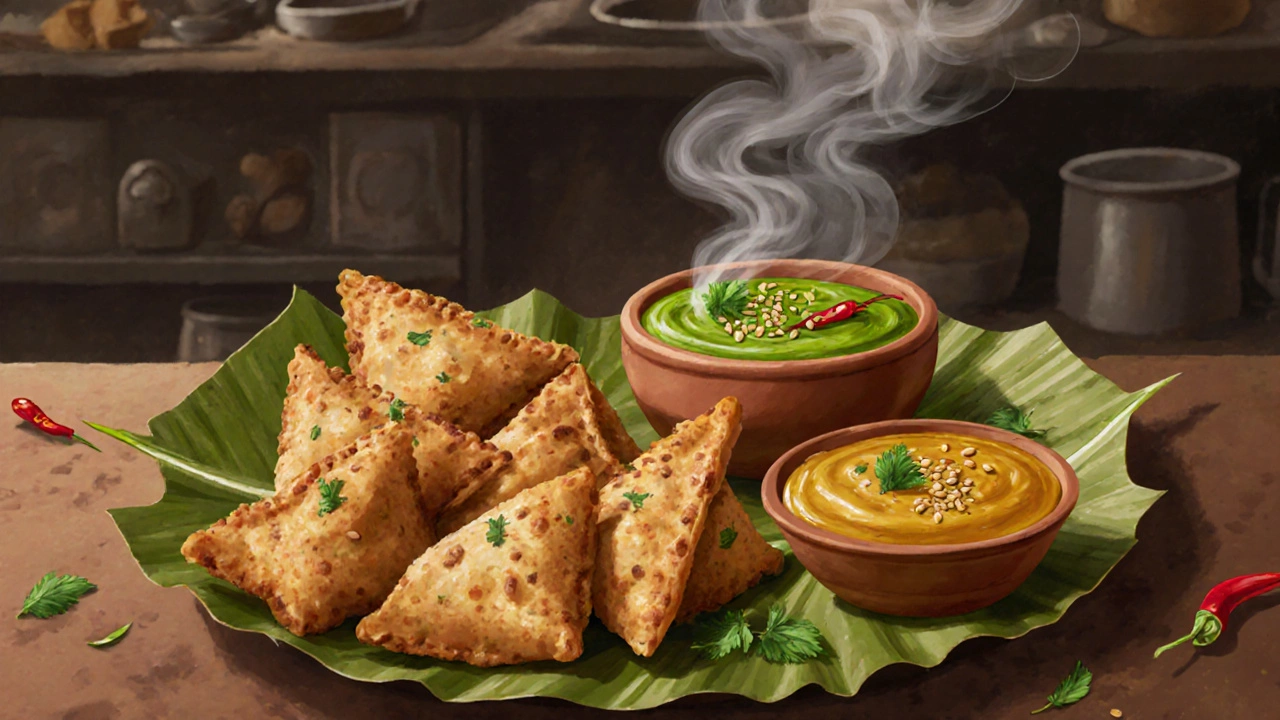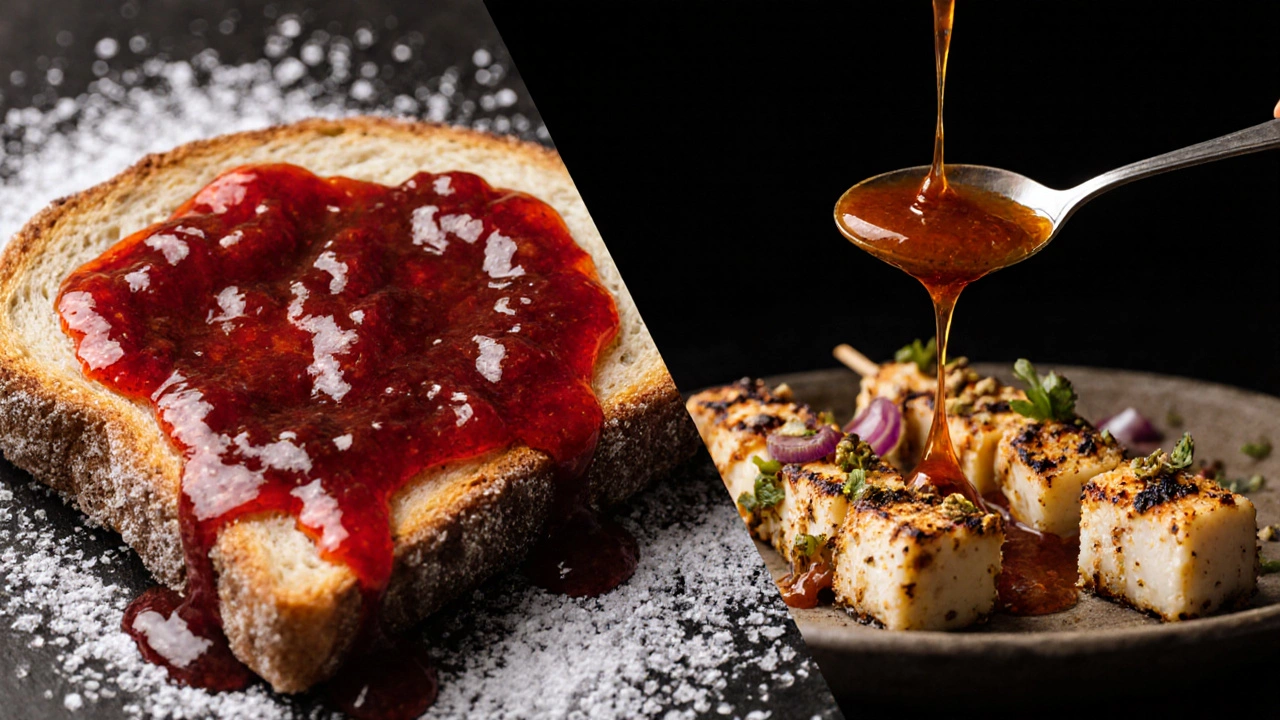
Chutney or Jam Selector
When to Use Chutney vs Jam
This tool helps you decide whether chutney or jam is the best choice for your dish based on the article's key differences in flavor, texture, and use.
Your Best Choice:
Chutney is ideal for dishes that need a flavor boost, condiment pairing, or tangy/spicy contrast to rich foods.
Why chutney?
Chutney's combination of sweet, sour, spicy, and salty elements makes it the perfect complement to fried foods, grilled meats, cheeses, and rice dishes. It cuts through richness and adds brightness to meals.
Your Best Choice:
Jam is ideal for sweet spreads on toast, yogurt, or pastries where the fruit flavor should shine.
Why jam?
Jam's sweet, smooth texture makes it perfect for breakfast, tea time, or desserts where fruit flavor is the main attraction. It's designed to be spreadable and enjoyed on its own.
Ever opened your pantry and stared at a jar of green chutney and a jar of strawberry jam, wondering why they look so similar but taste completely different? You’re not alone. Many people assume chutney and jam are just two names for the same sweet spread. But if you’ve ever had a bite of tangy tamarind chutney alongside a crispy samosa or spread peach jam on toast, you know they’re worlds apart. The difference isn’t just in flavor-it’s in history, ingredients, texture, and how they’re meant to be eaten.
Chutney Isn’t Just Sweet-It’s a Flavor Bomb
Chutney comes from the Indian subcontinent, where the word comes from the Sanskrit word chatni, meaning "to lick." It’s not a dessert. It’s a condiment. Think of it as a flavor accelerator. A good chutney doesn’t just sit beside your food-it wakes it up. Traditional chutneys balance sweet, sour, spicy, and salty all at once. Mango chutney might have sugar, but it also has vinegar, green chilies, ginger, and cumin. Tamarind chutney? Tart from the fruit, sweetened with jaggery, spiked with black salt and roasted cumin. Even coconut chutney, served with dosas, has roasted lentils and chili for depth.
Unlike jam, chutney is rarely made to be eaten alone. It’s paired with fried snacks, grilled meats, cheese, or rice dishes. It cuts through richness. It adds brightness. That’s why you’ll find it on charcuterie boards in modern kitchens, not just in Indian homes.
Jam Is All About Sweetness and Spreadability
Jam, on the other hand, is rooted in European preservation techniques. It’s made by cooking fruit with sugar and sometimes pectin until it thickens into a spreadable paste. The goal? To capture the fruit’s natural sweetness and turn it into something smooth, sticky, and shelf-stable. Strawberry jam, apricot jam, blueberry jam-they’re meant to be slathered on toast, stirred into yogurt, or layered in a scone.
Most jams have a higher sugar content than chutneys-often 60% or more by weight. That’s not an accident. Sugar acts as a preservative and gives jam its glossy, jelly-like texture. You won’t find vinegar, spices, or chilies in traditional jam recipes. There’s no need. The fruit is the star, and sugar is its sidekick.
Texture: Chunky vs Silky
Texture is one of the clearest ways to tell them apart. Chutneys are often coarse. You’ll see bits of onion, garlic, ginger, dried fruit, or even nuts. Even smooth chutneys like mint-coriander have a slightly gritty, herb-flecked feel because they’re blended quickly, not cooked down for hours.
Jam, by contrast, is meant to be uniform. It’s cooked slowly until the fruit breaks down completely. Some jams are strained for a silky finish. Others keep a few soft fruit pieces, but never anything crunchy or fibrous. If you bite into a spoonful of jam and feel a piece of peel or seed, you’re likely eating a preserve, not a true jam.

Ingredients: Spice vs Sugar
Here’s a quick breakdown:
- Chutney ingredients: Fruit or vegetables (mango, tamarind, coconut, tomato), vinegar or lemon juice, sugar or jaggery, spices (mustard seeds, cumin, chili, garlic, ginger), salt, sometimes nuts or dried herbs.
- Jam ingredients: Fruit, sugar, sometimes pectin (natural or added), lemon juice (for acidity), rarely spices beyond a hint of cinnamon or vanilla.
Chutney uses sugar as a balancing note, not the main ingredient. Jam uses sugar as the foundation. That’s why a tablespoon of mango chutney might have 5 grams of sugar, while the same amount of strawberry jam has 15 grams.
How They’re Used: Condiment vs Spread
Chutney is a side. It’s served with dosas, pakoras, kebabs, biryanis, or even grilled cheese sandwiches. It adds punch. It’s not meant to be the main event.
Jam is a centerpiece. You eat it on bread. You spread it thick. You eat it by the spoonful. It’s breakfast. It’s tea-time. It’s comfort.
Try this test: If you’d serve it with a cheese platter, it’s probably chutney. If you’d serve it with toast and butter, it’s jam.
Shelf Life and Storage
Both can last months in the fridge, but for different reasons. Chutney keeps because of vinegar and salt-natural preservatives that fight bacteria. Many traditional chutneys are made without sugar and still last for weeks. Tomato chutney, for example, relies on vinegar and oil to stay fresh.
Jam lasts because of sugar. High sugar content creates an environment where microbes can’t grow. That’s why you can store jam unopened on a shelf for a year. Chutney? Most need refrigeration, even if sealed. Homemade chutney without vinegar or oil can spoil in days.

Can You Substitute One for the Other?
Technically? Sometimes. But you’ll change the dish.
If you swap mango jam for mango chutney in a chicken curry, you’ll get a sweet, sticky sauce instead of a tangy, spicy one. The dish will lose its balance. Same with using strawberry jam on a samosa-it’ll clash with the fried dough and spices.
But there are exceptions. Some modern recipes blend the two. A sweet-and-spicy chutney made with figs and balsamic vinegar might blur the lines. But that’s fusion, not tradition.
Real-World Examples
Here’s what you’ll find in a typical Indian kitchen:
- Mango chutney: Made with raw or ripe mango, jaggery, red chilies, cumin, salt. Used with samosas, parathas, or as a dip.
- Coconut chutney: Fresh coconut, roasted chana dal, green chili, mustard seeds. Served with idlis and vadas.
- Tamarind chutney: Tamarind pulp, jaggery, cumin, black salt, chili. The classic street food pairing.
- Strawberry jam: Strawberries, sugar, lemon juice. Served on toast or in sandwiches.
- Apple butter: Slow-cooked apples, cinnamon, sugar. Smooth, rich, spreadable-technically a preserve, not a jam, but closer to jam than chutney.
Notice how none of the chutneys are eaten alone? That’s the rule.
Why This Matters in Cooking
Understanding the difference helps you cook better. If a recipe calls for chutney and you use jam, you’ll ruin the flavor balance. If you’re making a vegan burger and want a tangy kick, reach for tamarind chutney-not apricot jam. If you’re making a fruit tart and need a sweet, glossy topping, jam is your friend. Chutney won’t hold up.
It’s not about which is better. It’s about which is right for the dish.
Can chutney be sweet?
Yes, many chutneys are sweet-especially those made with ripe mango, dates, or figs. But even sweet chutneys include sour, spicy, or salty elements to balance the sugar. Sweetness alone doesn’t make it jam.
Is jam the same as jelly or preserve?
No. Jam contains crushed or chopped fruit. Jelly is made from strained fruit juice and is clear and firm. Preserves include whole or large pieces of fruit. All three are sweet spreads, but none are chutney.
Can I make chutney without sugar?
Absolutely. Many traditional chutneys, like tomato or coriander chutney, use little to no sugar. Salt, vinegar, and spices provide flavor and preservation. Sugar is optional-it’s there to soften the tang, not to sweeten the dish.
Why does chutney taste better after a few days?
Chutneys develop flavor as the spices and acids meld together over time. The vinegar softens the raw edge of garlic and chili, and the sugar (if used) integrates fully. This is why homemade chutney often tastes better after sitting for 2-3 days in the fridge.
Is mango chutney the same as mango jam?
No. Mango chutney includes vinegar, spices, and salt. Mango jam is just mango and sugar, cooked until thick. One is a savory condiment; the other is a sweet spread. They’re made from the same fruit, but they’re completely different products.